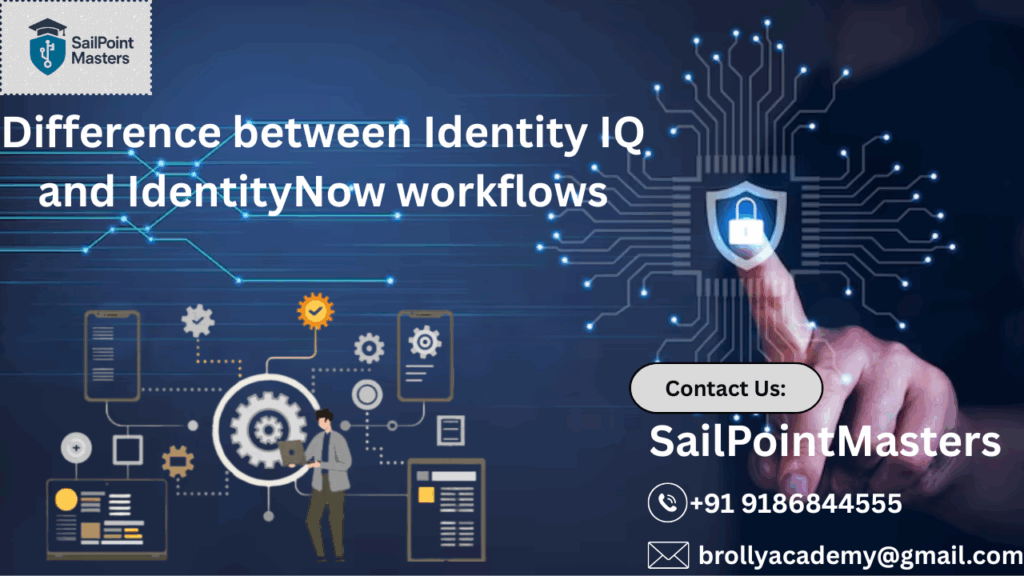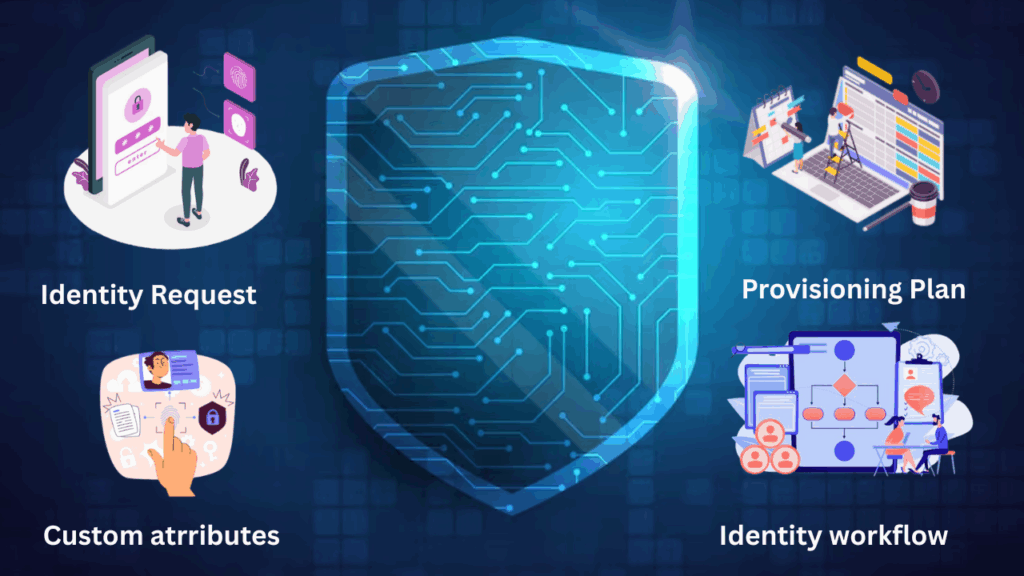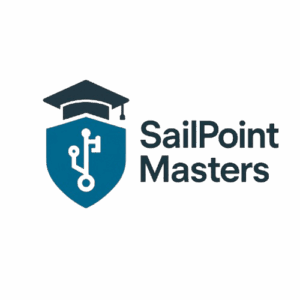Difference between Identity IQ and IdentityNow Workflows

Difference between Identity IQ and IdentityNow Workflows
Table of Contents
ToggleIn today’s rapidly evolving digital landscape, organizations are managing increasingly complex identity systems. With a growing number of users—employees, contractors, partners, and even bots—accessing various applications and sensitive data, maintaining security, ensuring compliance, and managing user access have become critical challenges. Add to this the pressure of adhering to strict regulatory requirements like GDPR, HIPAA, or SOX, and it becomes clear that traditional manual identity processes are no longer sufficient. Modern Identity and Access Management (IAM) platforms like SailPoint offer workflow-driven automation to streamline these tasks. However, understanding the difference between IdentityIQ and IdentityNow workflows is essential for organizations and professionals aiming to choose the right solution for their IAM strategy in 2025.
SailPoint Workflows are part of the broader Identity Security platform that enables businesses to automate identity-related tasks—such as user provisioning, deprovisioning, access approvals, role changes, and compliance certifications. By automating these processes, organizations can significantly reduce manual workload, enhance security, and ensure policy-driven access control across all systems.
If you’re new to Identity and Access Management (IAM), this beginner’s guide will help you explore:
- What SailPoint Workflows are
- Why they’re essential in modern IT environments
- How they streamline identity operations
- Common real-world use cases
- Benefits for IT teams and security operations
Whether you’re an IT admin, security analyst, or a newcomer trying to understand the identity lifecycle, this guide will equip you with the foundational knowledge to start exploring SailPoint workflows confidently.
What are SailPoint Workflows?
SailPoint Workflows are automated, customizable processes that streamline a wide range of identity governance actions such as user provisioning, access requests, approvals, access certifications, and deprovisioning. These workflows are integral to both SailPoint IdentityIQ and SailPoint IdentityNow, empowering organizations to create rule-based, event-driven sequences that manage identity lifecycle tasks with greater accuracy, speed, and compliance.
Whether it’s a new hire onboarding, role changes, or user offboarding, SailPoint workflows enable seamless automation without manual intervention. For example, when a new employee joins, a workflow can automatically assign appropriate access based on role, department, and location—ensuring immediate productivity while maintaining least privilege access principles.
Some additional key capabilities and benefits of SailPoint Workflows include:
- Drag-and-drop visual workflow builders (especially in IdentityNow) that simplify workflow creation for non-technical users.
- Integration with third-party systems (like ServiceNow, Azure AD, Workday, etc.) to support end-to-end identity operations.
- Policy enforcement built directly into the workflow, ensuring access decisions comply with regulatory and internal policies.
- Conditional logic and triggers that respond to real-time events (e.g., termination, role change, access review results).
- Auditable logs and reporting for governance, risk, and compliance (GRC) requirements—essential for passing audits.
- Improved IT efficiency by reducing repetitive tasks, minimizing human errors, and lowering administrative overhead.
- Support for cloud and hybrid environments, making workflows scalable across on-premise and SaaS applications.
Whether it’s access request workflows in SailPoint or automated identity governance across enterprise applications, workflows form the core of identity automation. They not only save time and boost security but also help organizations stay audit-ready and future-proof their IAM strategy.

Why Are Workflows Important in Identity Governance?
Automate Repetitive Tasks like Onboarding/Offboarding
SailPoint workflows help automate time-consuming and repetitive identity lifecycle tasks, such as employee onboarding and offboarding. When a new employee joins the organization, a workflow can automatically provision access to required systems, email accounts, and applications based on their job role, department, and location. Similarly, when an employee leaves, the workflow can trigger automated deprovisioning, ensuring all access is revoked instantly—reducing the risk of orphaned accounts and unauthorized access.
Manage User Provisioning Automation
Provisioning access manually across multiple applications is slow, error-prone, and inefficient. SailPoint workflows streamline user provisioning by automating account creation, updates, and removal across on-premises and cloud systems. Workflows ensure that provisioning is accurate, role-based, and compliant with policies, reducing reliance on IT teams while ensuring users get timely access to the tools they need.
Enforce Access Policies and Controls
With SailPoint workflows, organizations can enforce access governance policies automatically. For example, workflows can check if access requests violate Segregation of Duties (SoD) policies before approving them. This helps organizations embed security controls directly into the identity lifecycle, ensuring every access decision complies with business rules and reduces exposure to risk.
Improve Compliance Through Policy Enforcement Workflows
Regulatory frameworks like GDPR, HIPAA, SOX, and ISO 27001 require stringent access controls and audit trails. SailPoint workflows help enforce these requirements through automated access reviews, certifications, and policy-based approvals. These workflows generate auditable logs and reports, making it easier for organizations to demonstrate compliance during audits and reduce non-compliance penalties.
Reduce Risk with Identity Governance Automation
Manual identity processes often lead to inconsistent access, excessive privileges, and increased security vulnerabilities. By automating identity governance tasks—such as periodic access reviews, risk analysis, and policy enforcement—SailPoint workflows help minimize identity-related risks. This reduces the likelihood of insider threats, data breaches, and compliance violations.
Speed Up Decisions Using SailPoint Approval Workflows
SailPoint includes powerful approval workflows that allow managers and application owners to review and approve access requests efficiently. Instead of relying on back-and-forth emails or tickets, automated workflows route requests through predefined approval chains, apply business logic, and provide real-time visibility. This speeds up access decisions, boosts productivity, and ensures timely access without compromising on security.
Types of SailPoint Workflows
1.Provisioning Workflow
Handles the automatic creation or removal of user accounts in applications based on access rights or job roles. This helps in identity lifecycle management workflows and ensures no unnecessary access is left behind.
2. Access Request Workflow
Users can request access to certain apps or data. These requests pass through defined approval paths (like managers or IT admins) before granting access. This is crucial for compliance workflows in SailPoint.
3. Certification Workflow
Used to certify user access periodically. It automates reviews for specific users, groups, or roles.
4. Custom Integration Workflows
These workflows connect SailPoint with third-party systems like HRMS, cloud services, or ITSM tools. Often used in SailPoint integration workflows for data syncing and automation.
Difference between IdentityIQ and IdentityNow workflows
Creating workflows in SailPoint depends on which platform you’re using — IdentityIQ or IdentityNow. While both tools aim to automate identity lifecycle processes, the approach to building and managing workflows differs significantly based on the platform.
SailPoint IdentityIQ Workflows
SailPoint IdentityIQ is a highly customizable, on-premises identity governance platform used primarily by large enterprises with complex IAM needs. Workflows in IdentityIQ are defined using XML-based configuration files, which allows for deep control and flexibility. You can build advanced, condition-based workflows that integrate tightly with enterprise systems.
Key characteristics:
- Built with XML scripts and logic nodes
- Requires knowledge of workflow syntax, BeanShell scripting, and IdentityIQ’s internal schema
- Ideal for complex and custom identity flows such as multi-level approvals, SoD conflict resolution, and dynamic provisioning
- Integrated with IdentityIQ’s broader lifecycle event triggers, such as identity creation, updates, and certifications
Allows versioning and audit tracking for change control
SailPoint IdentityNow Workflows
SailPoint IdentityNow is a cloud-native IAM platform designed for agility and ease of use. Workflows in IdentityNow are created using a low-code visual interface — no XML or scripting needed. This makes it easier for non-developers (such as identity analysts or IT admins) to build and deploy workflows quickly.
Key characteristics:
- Built with visual workflow builders using a drag-and-drop canvas
- Supports predefined triggers and actions, such as “When user joins,” “When access is requested,” etc.
- Allows you to integrate with SaaS applications and directories like Azure AD, Workday, Okta, Salesforce, etc.
- Includes built-in connectors and templated workflows for common use cases
- Easier to maintain, audit, and scale as your identity requirements evolve
SailPoint Workflow Tutorial for Beginners
Here’s a simplified step-by-step example of creating a workflow in SailPoint IdentityNow:
Trigger: A New Employee Is Added in the HR System
- The workflow is initiated when the HR system (e.g., Workday or SAP SuccessFactors) detects a new hire record.
- Integration between SailPoint IdentityNow and the HR system enables real-time identity ingestion.
- The trigger ensures the workflow begins immediately after the employee’s profile is created, helping avoid delays in access provisioning.
.Condition: Employee job title is “Software Engineer”.
- The workflow checks the new employee’s job title field from the HR data.
- Conditional logic is used to filter only those whose title matches “Software Engineer”.
- You can also include other attributes like department, location, or employment type for more specific targeting.
Action:based on the job title, the workflow automatically provisions the necessary accounts :
- GitHub – for source code collaboration
- Slack – for team communication
- Jira – for project and task tracking
This is done using out-of-the-box connectors or via custom API calls in IdentityNow. The accounts can also be configured with appropriate roles, teams, or permission levels.
Approval Step:
- Before provisioning completes, the request is routed to the employee’s assigned manager.
- The manager receives an approval notification in their IdentityNow dashboard or email.
- They can approve, reject, or delegate the access request based on business need.
Notification:
- Once the workflow completes, automated email notifications are sent to:
- HR – confirming the employee’s onboarding status
- IT Team – for awareness or follow-up tasks like hardware assignment
Notifications can also include workflow logs, timestamps, and any exceptions or issues.
Learning Path: Where to Start with SailPoint Workflows?
If you’re new to SailPoint and identity governance, the best way to get started is by enrolling in a SailPoint certification course. Whether you’re pursuing a career in IAM (Identity and Access Management), cybersecurity, or enterprise IT operations, gaining hands-on skills in SailPoint workflows can open doors to high-demand roles.
Several institutes, especially in Hyderabad, offer beginner-friendly SailPoint training that covers both SailPoint IdentityIQ and IdentityNow, with a strong focus on workflow automation.
Top Focus Areas in a SailPoint Certification Training in Hyderabad
Here are the key topics and skills typically covered in a high-quality SailPoint training program:
Workflow Design and Execution
- Learn how to build, deploy, and manage workflows for common IAM use cases (onboarding, offboarding, access reviews, etc.).
- Understand XML-based workflow development in IdentityIQ.
- Use low-code visual builders in IdentityNow to create event-based automation flows.
- Learn how to debug and troubleshoot workflow issues.
Integration with Enterprise Systems
- Connect SailPoint with HRMS platforms like Workday or SAP SuccessFactors.
- Integrate with directories (Active Directory, Azure AD), cloud platforms (AWS, Google Workspace), and SaaS apps (Salesforce, GitHub, Jira).
- Learn about REST APIs and connectors for seamless data exchange.
Governance and Compliance Automation
- Automate access certifications, policy enforcement, and role-based access control (RBAC).
- Understand how workflows contribute to audit readiness and regulatory compliance (e.g., GDPR, SOX, HIPAA).
- Implement Segregation of Duties (SoD) checks via automated workflows.
Hands-On Labs for Creating Workflows
- Practical labs for building onboarding/offboarding workflows.
- Simulate real-world identity scenarios with approval chains, notifications, and conditional logic.
- Build and test automated provisioning and deprovisioning flows.
Identity Lifecycle Management
- Understand the full identity lifecycle — from identity creation to termination.
- Learn how SailPoint workflows automate key lifecycle stages.
- Use lifecycle event triggers to initiate actions based on changes in user attributes.
Monitoring, Logging & Reporting
- Use SailPoint’s tools to monitor workflow execution and track success/failure logs.
- Learn how to generate custom reports and use workflow data for compliance and optimization.
Security & Risk Management
- Apply risk scores and access models to make intelligent access decisions within workflows.
- Design workflows that prevent overprovisioning and reduce identity-related risk.
Real-World Projects & Case Studies
- Study how SailPoint workflows are implemented in banking, healthcare, and IT enterprises.
- Get insights into best practices and optimization strategies for large-scale environments.
Benefits of Automating with SailPoint Workflows
- Time-saving through automation
- Reduced human errors
- Faster onboarding/offboarding
- Improved compliance reporting
- Streamlined IAM operations
Conclusion:
Understanding how SailPoint workflows function is not just a technical skill — it’s a strategic capability for anyone working in identity governance, access management, or enterprise security.
Whether you’re:
- A beginner exploring workflow automation in SailPoint IdentityNow,
- An IT administrator aiming to streamline user access provisioning,
- Or a cybersecurity professional looking to specialize in advanced IAM solutions like SailPoint IdentityIQ,… mastering workflows will give you the confidence and competence to manage identities efficiently, securely, and at scale.
